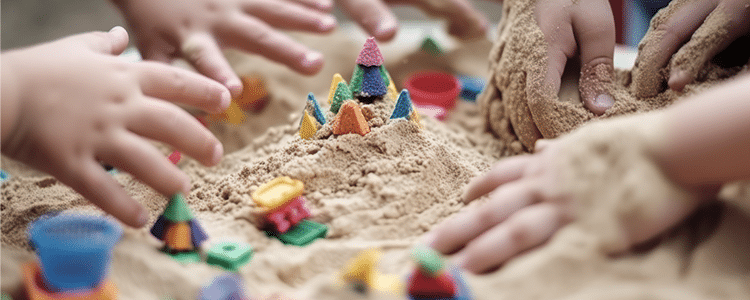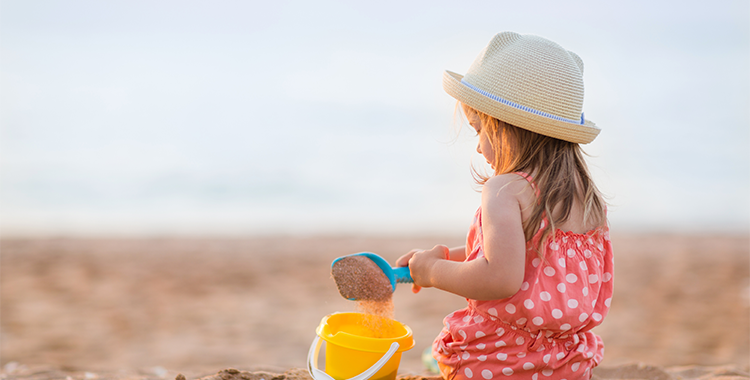Celebrate the wonder of nature’s largest playground with a trip to the seaside on National Beach Day. Or, set up a paddling pool, bring in a truckload of sand, and create a beach-like environment for the children to enjoy and explore at the nursery.
This Summer, many children across the county have had the opportunity to experience the joy of being on the beach. With buckets and spades in tow, they have spent the day digging in the sand, building sandcastles and splashing in the ocean. With the soothing sound of waves in the background and the sensation of saltwater on their skin, they become carefree and relaxed, fully immersing themselves in the sensory wonders of nature’s vast playground.
But many children have never stepped foot on a beach. They have not rolled down a sand dune, explored the sea life contained in a rock pool or touched a piece of slippery seaweed. National Beach Day, which takes place on 30 August each year, is a day dedicated to celebrating the beauty and importance of beaches. Not only is it about spending time on the beach enjoying the sun, sand, and sea but it also about raising awareness of the need to protect and preserve beaches in the face of pollution and erosion. Many people take part in beach clean-up activities to promote environmental awareness.
How nurseries celebrate the day?

Nurseries can celebrate the joy and wonder of the beach by taking a trip to the local seaside or by bringing the beach to the setting.
Some settings, such as Naturally Learning in Cornwall, run daily Beach School sessions which harnesses the magic of the ocean and the charm of coastal environments to inspire curiosity, creativity, and a deep connection with nature.
Through its seasonal curriculum, children explore the beauty of the changing seasons at the beach. They forage for seaweed that has been churned up by storms, they observe changes in the weather and different wildlife behaviour, and they collect natural treasures. They also play run-away-wave, make stone sculptures, throw rocks, or create transient art pieces in the sand. Daily beach sweeps where they collect rubbish helps foster an early appreciation of the natural world.
Elements of the beach can also be found back at the setting. Babies clamber into seaweed baths in their nappies, seeking out a whole-body sensory experience. And tuff spots are transformed into rockpools with seaweed, shells and pebbles.
Beach School is full of learning opportunities and ticks every aspect of the Early Years Foundation Stage. It is great for physical development as children use their whole bodies to pick up large rocks and transport them around the beach, throw pebbles into the sea or clamber over uneven surfaces.
But if daily trips to the beach are not an option, a one-off daytrip to the coastline, whether it’s a beach or the riverbank, can be an awe-inspiring experience for a young child. Just feeling the sea breeze on their face and the sand between their toes provides a deep sensory experience which can stimulate the senses and help create a sense of calm.
Tips and ideas for your visit to the seaside

Here are some tips and ideas for your visit to the seaside or a coastal location:
- It is vital to consider whether or not the location is appropriate for a visit. Check the weather and the tide and visit the beach at different states of the tide before you head off. Activities will depend on whether the tide is in or out, and this is also an important safety consideration so do a thorough risk assessment. Also, when you arrive on the beach, do some general beachcombing, looking for litter and hazardous items, as well as pointing out the boundaries where the children should not go beyond.
- When at the beach, do a treasure hunt where children find interesting objects, pebbles, seaweed and shells. Bring a reference book so that children can match and sort the different species of seaweed or identify crabs, shrimp, limpets, snails and sea anemones.
- Do some learning prior to the trip. For example, read the book Sharing a Shell by Julia Donaldson and ask the children, ‘What can you see in the rock pool?’, ‘What might be under there?’, ‘If you were a barnacle – what might it feel like to live in there’, ‘How big are they compared to us?’
- Look at the different track marks imprinted into the sand and try to work out what they are. They might be made by boats or the large Caterpillar trucks that clean up the beach. Take photos of the findings and reference them back at the nursery.
- Mark-make children’s initials in the sand and encourage them to decorate them with feathers, shells, seaweed and stones.
- Let children dig holes and build sandcastles and knock them over. Provide buckets and spades and let children use their imaginations to create small worlds with pebbles or driftwood found on the beach.
- Give them time and space to just be. They may want to sit quietly, sifting the sand beneath their fingers and listening to the sound of chirping seagulls.
- Don’t forget the ice creams. A visit to the English seaside wouldn’t be complete without a Mr Whippy.
Beach day

The exact feeling that a child experiences on a trip to the beach cannot be replicated in a nursery setting but it can be recreated through role-play opportunities and small-world play. Practitioners can provide plenty of natural resources like sand, water, shells, pebbles, rocks and seaweed to arouse their curiosity and extend their learning.
With a bit of forward planning, adventurous nursery settings can bring the beach to the nursery. With a ton of sand, paddling pools, buckets and spades and a bit of Summer sunshine (perhaps less likely this year!), the outdoor area can be transformed into a seaside scene that will give children a ‘day out’ to remember.
Here are some ideas:
- Set up role-play areas with sand, a paddling pool, deck chairs, summer clothing and sunglasses, following children’s interests and their real-life experiences of the seaside. Mimic this in small world play, creating seaside scenes with dry sand, pebbles, gravel, rocks, small world people, boats, an ice cream van, buckets made out of toothpaste lids and pieces of fabric for towels.
- Fill an inflatable paddling pool with sand and add shells, stones and seaweed collected from the beach to make it more realistic. Place baskets containing sunglasses, swimming costumes, empty bottles of suntan lotion and hats alongside.
- Talk about children’s experiences of the beach and the wildlife and creatures they have observed in the rockpools.
- Print out images of beaches around the walls and photos of children at the beach, along with pictures of shells, the sea and fish.
- Create role play scenarios, which can be extended as children’s interests develop. For example, add suitcases so that children can ‘pack’ for holiday, make passports and talk about the different ways to travel.
- If you want to make a day out of it, why not invite the ice cream man to turn up – his jolly tunes will delight the children. Adventurous settings with plenty of outdoor space could go one step further and hire donkeys for children to ride on.
The seaside offers endless opportunities to enrich and enhance children’s play. Whether you take children on a trip to the beach or bring elements of the seaside into the nursery, the learning experiences will be invaluable.

Nicole
Content Creator




